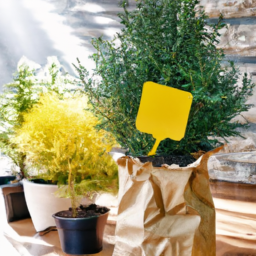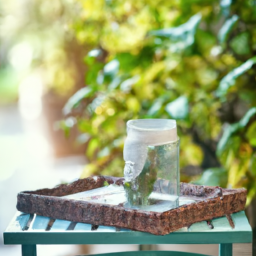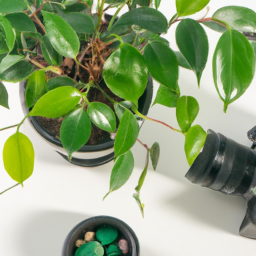
Have you ever wondered, “Can I put indoor plants outside?” If you’re like many plant enthusiasts, you may be curious about whether your beloved houseplants can thrive in an outdoor environment. In this blog post, we’ll explore the factors to consider when moving your indoor plants outside and provide tips for successfully transitioning them to the great outdoors. Whether you’re looking to give your plants a breath of fresh air or simply want to experiment with new growing conditions, read on to learn more about the possibilities of bringing your indoor plants outside.
Benefits of Moving Indoor Plants Outside
Introduction
Many people wonder whether it is okay to move their indoor plants outside. The good news is that most indoor plants can thrive outdoors with proper care and attention. In fact, there are several benefits to moving your indoor plants outside, including increased sunlight exposure, better air circulation, and access to natural humidity. In this article, we will discuss the benefits of moving indoor plants outside and provide a step-by-step guide on how to do so successfully.
Increased Sunlight Exposure
One of the main benefits of moving indoor plants outside is increased sunlight exposure. Most indoor plants are accustomed to low light conditions indoors, which can hinder their growth and development. By moving them outside, you can provide them with the bright, direct sunlight they need to thrive. Sunlight is essential for photosynthesis, the process by which plants convert light into energy. Without enough sunlight, indoor plants may become leggy, pale, and weak. Moving them outside can help them grow stronger, healthier, and more vibrant.
In addition to sunlight exposure, outdoor plants also benefit from natural air circulation. Indoor plants are often exposed to stagnant, dry air indoors, which can lead to pest infestations and diseases. By moving them outside, you can ensure that they receive fresh, oxygen-rich air that promotes healthy growth. Outdoor plants also benefit from natural humidity levels, which can help prevent issues such as leaf browning and wilting. Overall, moving indoor plants outside can provide them with the ideal growing conditions they need to thrive.
When moving your indoor plants outside, it is important to acclimate them gradually to prevent shock. Start by placing them in a shaded area for a few hours each day, gradually increasing their exposure to sunlight over time. Be sure to water them regularly and monitor their growth closely to ensure they are adjusting well to their new environment. With proper care and attention, your indoor plants can flourish outdoors and bring beauty to your outdoor space.
Conclusion
In conclusion, moving indoor plants outside can provide them with numerous benefits, including increased sunlight exposure, better air circulation, and access to natural humidity. By following the steps outlined in this article, you can successfully move your indoor plants outside and help them thrive in their new environment. Remember to acclimate them gradually, provide them with adequate sunlight and water, and monitor their growth closely. With proper care and attention, your indoor plants can flourish outdoors and enhance the beauty of your outdoor space.

Tips for Transitioning Indoor Plants to an Outdoor Environment
Understanding Your Indoor Plants
Before you decide to move your indoor plants outside, it’s important to understand the specific needs of each plant. Some plants thrive in direct sunlight, while others prefer shade. Take note of the current environment your plants are in and research the optimal conditions for each plant.
Indoor plants are accustomed to controlled temperatures and lighting conditions, so sudden changes can shock the plants. Gradually introduce your plants to the outdoor environment by placing them in a shaded area for a few hours each day. This will help them acclimate to the new conditions without causing stress.
It’s also important to consider the season when transitioning your indoor plants outside. Spring and early summer are ideal times to move your plants outdoors, as the weather is mild and plants are entering their growing season. Avoid moving plants outside during extreme temperatures or harsh weather conditions.
Preparing Your Plants for the Outdoors
Before moving your indoor plants outside, it’s essential to inspect them for any pests or diseases. Indoor plants are more susceptible to pests due to the controlled environment, so it’s crucial to treat any issues before exposing them to the outdoor environment.
Repotting your plants before moving them outside can also help promote healthy growth. Check the roots of your plants for any signs of overcrowding or root rot, and repot them into a larger container if necessary. This will provide your plants with fresh soil and room to grow in their new outdoor environment.
Watering your plants appropriately is key to their success outdoors. Indoor plants may require more frequent watering when moved outside, as they are exposed to more sunlight and higher temperatures. Monitor the moisture levels of the soil and adjust your watering schedule as needed to prevent over or under watering.
Caring for Your Plants Outdoors
Once your indoor plants are successfully transitioned to an outdoor environment, it’s important to continue monitoring their growth and health. Regularly check for pests, diseases, and signs of stress, and take action promptly to prevent any issues from spreading.
Provide your plants with the necessary nutrients to support their growth outdoors. Consider using a slow-release fertilizer or organic compost to feed your plants throughout the growing season. Be mindful of the specific needs of each plant, as some may require more frequent feeding than others.
Lastly, remember to protect your plants from extreme weather conditions such as strong winds, heavy rain, or intense sunlight. Consider using plant covers, shade cloths, or moving your plants to a more sheltered area to prevent damage. With proper care and attention, your indoor plants can thrive in their new outdoor environment.

Factors to Consider Before Placing Indoor Plants Outside
Light Exposure
When considering whether to move your indoor plants outside, one of the most important factors to consider is the amount of light exposure they will receive. Indoor plants are accustomed to lower light levels than outdoor plants, so it’s essential to gradually acclimate them to the increased sunlight they will experience outside. Start by placing your plants in a shaded area outside for a few hours each day, gradually increasing the amount of time they spend in direct sunlight. This will help prevent sunburn and shock to the plants.
Additionally, it’s important to consider the specific light requirements of each plant. Some plants thrive in full sun, while others prefer partial shade. Research the light requirements of your indoor plants before moving them outside to ensure they will receive the appropriate amount of sunlight.
Another factor to consider is the intensity of the sunlight. Outdoor sunlight is much more intense than indoor light, so it’s important to monitor your plants for signs of sunburn, such as yellowing or browning leaves. If you notice any signs of sun damage, move your plants to a shadier location or provide them with some protection from the sun, such as a sheer curtain or shade cloth.
In addition to sunlight, it’s also important to consider the length of the daylight hours. Indoor plants are accustomed to consistent light levels year-round, so moving them outside during the summer months when the days are longer can be beneficial. However, during the winter months when the days are shorter, it may be necessary to supplement with artificial light to ensure your plants receive enough light to thrive.
Temperature and Humidity
Another important factor to consider before placing indoor plants outside is the temperature and humidity levels. Indoor plants are typically grown in controlled environments with stable temperatures and humidity levels, so it’s important to consider how the outdoor conditions will affect your plants.
Before moving your plants outside, research the temperature and humidity requirements of each plant to ensure they will be able to thrive in the outdoor environment. Some plants are more sensitive to temperature fluctuations and may not do well outside if the temperatures are too hot or too cold. Similarly, some plants require higher humidity levels to thrive, so it’s important to monitor the humidity levels and provide additional moisture if necessary.
It’s also important to consider the seasonal changes in temperature and humidity. While your plants may thrive outside during the summer months, they may struggle during the winter months when temperatures drop and humidity levels decrease. Consider bringing your plants back inside during the winter months or providing them with additional protection, such as a greenhouse or cold frame, to help them survive the colder weather.
In addition to temperature and humidity levels, it’s important to consider the potential for extreme weather events, such as strong winds, heavy rain, or hail. These can all damage your plants, so it’s important to monitor the weather forecast and take precautions to protect your plants from any potential harm.
Pests and Diseases
One final factor to consider before placing indoor plants outside is the potential for pests and diseases. Outdoor environments can harbor a variety of pests, such as aphids, spider mites, and whiteflies, as well as diseases, such as powdery mildew and root rot, that can damage your plants.
Before moving your plants outside, inspect them carefully for any signs of pests or diseases. Look for yellowing or distorted leaves, sticky residue on the leaves, or webbing on the plant, which are all signs of pest infestations. Additionally, check the soil for any signs of mold, mildew, or rot, which can indicate a potential disease problem.
To prevent pests and diseases from affecting your plants, it’s important to practice good plant hygiene. Remove any dead or damaged leaves, regularly clean the leaves with a damp cloth to remove dust and debris, and avoid overcrowding your plants, which can create a breeding ground for pests and diseases.
Consider using natural pest control methods, such as introducing beneficial insects like ladybugs or using neem oil or insecticidal soap to control pest infestations. Additionally, avoid overwatering your plants, as excess moisture can create the perfect conditions for mold, mildew, and rot to thrive.
By considering these factors before placing your indoor plants outside, you can help ensure that they will thrive in their new environment and continue to bring beauty and joy to your home. Remember to monitor your plants regularly, provide them with the care and attention they need, and enjoy watching them grow and flourish in the great outdoors.
I’ll leave you with these final thoughts
If you’ve been wondering whether you can move your indoor plants outside, the answer is yes! Many indoor plants can thrive outdoors, as long as you make sure to acclimate them properly. Start by gradually exposing your plants to the outdoor environment, starting with a few hours of sunlight and gradually increasing the time over a period of a few weeks. This will help prevent shock and ensure that your plants are able to adjust to the new conditions.
Before moving your indoor plants outside, make sure to consider the specific needs of each plant. Some plants may require more sunlight, while others may need more water or protection from pests. Take the time to research the individual requirements of each plant and make adjustments as needed. By following these steps, you can successfully move your indoor plants outside and enjoy the benefits of having greenery both indoors and outdoors.
Your Questions Answered. Comprehensive FAQ:
Q1. Can I put indoor plants outside?
A1. Yes, you can put indoor plants outside, but it’s important to consider the specific needs of each plant before moving them outdoors. Some indoor plants may not thrive in outdoor conditions, so it’s best to research each plant’s requirements before making the move.
Q2. What should I consider before moving indoor plants outside?
A2. Before moving indoor plants outside, consider factors such as sunlight exposure, temperature, humidity, and wind conditions. Make sure the outdoor environment is suitable for the specific needs of each plant to ensure they thrive in their new surroundings.
Q3. How should I acclimate indoor plants to outdoor conditions?
A3. To acclimate indoor plants to outdoor conditions, gradually introduce them to the outdoor environment by placing them in a shaded area for a few hours each day, gradually increasing their exposure to sunlight and outdoor elements. This gradual transition will help prevent shock to the plants.
Q4. Can indoor plants benefit from being outside?
A4. Yes, indoor plants can benefit from being outside as they will receive more natural sunlight, fresh air, and potentially higher humidity levels. Outdoor conditions can help indoor plants grow stronger, develop vibrant foliage, and even bloom more frequently.
Q5. How do I care for indoor plants once they are outside?
A5. Once indoor plants are outside, continue to monitor their water and nutrient needs, as outdoor conditions may require more frequent watering or fertilizing. Protect plants from extreme weather conditions and pests, and enjoy watching them thrive in their new outdoor environment.
Dr. Olivia Green is a botanist with over two decades of experience in indoor plant cultivation. She holds a Ph.D. in Plant Biology and has dedicated her career to researching plant behavior in controlled environments. Dr. Green is passionate about helping plant enthusiasts master the art of indoor gardening through her extensive knowledge and practical insights.


